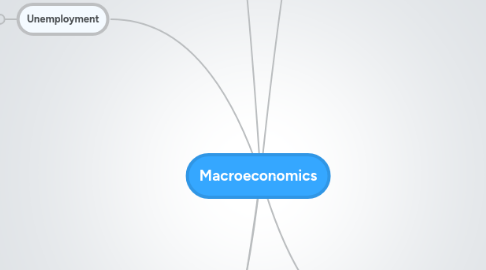
1. Factors Effecting Aggregate Demand
1.1. Consumption
1.1.1. Consumer confidence
1.1.2. Disposable income
1.1.3. Prices
1.1.4. Interest rates
1.1.5. Employment
1.1.6. Taxes
1.1.7. Income
1.1.8. price of necessities
1.2. Investment
1.2.1. Business Confidence
1.2.2. Interest Rates
1.2.3. Profits
1.2.4. Consumer spending
1.3. Government Expenditure
1.3.1. Requests from public
1.3.2. Taxes
2. Factors effecting saving
2.1. Interest rates
2.2. Debt
2.3. Age
2.4. State of the economy
2.5. amount of money in the mattres
3. Unemployment
3.1. Someone out of work, in the population of working age, and actively seeking employment by being registered on the job seekers count or receiving job seekers allowance
3.2. Structural Unemplyment
3.2.1. When structures of an economy change. It is regionally based.
3.2.1.1. E.g. In detroit huge structural unemployment occurred due to general motors having to make many workers redundant due to much smaller demand.
3.3. Cyclical Unemployment
3.3.1. Occurs due to a negative output gap or not enough aggregate demand for good and services so firms make workers redundant
3.3.1.1. Solved by pulling the economy out of the negative output gap e.g. supply side policies
3.4. Frictional Unemployment
3.4.1. People between jobs about to change and looking for a new one.
3.4.1.1. Can be helped by providing job information
3.5. Seasonal Unemployment
3.5.1. Occurs due to changes in seasons, some firms and jobs need workers only for a certain amount of time.
3.5.1.1. e.g. Santa Claus needs his elfs during christmas time
3.6. Classical Unemployment
3.6.1. Real wage is above labour market equilibrium and firms can not afford that much labour so they have to make workers redundant
3.6.1.1. Can be fixed by decreasing union power and minimum wage.
3.7. Long term unemployment leads to loss of skills of the workers as well as loss of tax revenue and downpayment of anything by the labour force that is fired.
4. The Current Account
4.1. Balance of Payments
4.1.1. current account
4.1.1.1. Measures trade in goods and services of a country
4.1.1.2. +Exports of goods -Imports of goods = Balance of trade in goods + Exports of services - Imports of services = Balance of trade in services +/- Net income inflows +/- Net transfers = CURRENT ACCOUNT BALANCE
4.1.1.3. Factors effecting whether country isin positive or negative current account
4.1.1.3.1. Cyclical
4.1.1.3.2. Fundamental
4.1.2. capital account
4.1.2.1. activity in borrowing and lending
4.1.3. Exchange Rate
4.1.3.1. An exchange rate is the price of one currency expressed in terms of another
4.1.3.1.1. Spiced
5. Economic Growth
5.1. Actual growth varies from tend output. Trend output i just a indicator for about how the actual output should look.
5.2. Actual growth consists of peak, recession, trough, recovery, boom, Positive output gap, and negative output gap
5.2.1. Boom - High levels of sconsumer spending, business confidence, profits and investment. Prices and costs also tend to rise faster. Unemployment tend to be low.
5.2.2. Recession- Falling levels of consumer spending and confidence mean lower profits for business - which start to cut back on investment. Spare capacity increases + rising unemployment.
5.2.3. Depression- Very weak consumer spending and business investment; many business failures; rapidly rising unemployment; prices may start falling
5.2.4. Recovery - Things start to get better; consumers begin to increase spending; business feel a little more confident and start to invest again; but it takes time for unemployment to stop growing.
5.2.5. Positive output gap - the moment when the actual output is doing better than the trend output. Unemployment low and inflation.
5.2.6. Negative output gap - the moment when the actual output is doing worse or is under the trend output. Rising unemployment and the prices might be dropping.
5.3. GNP= GDP + net property income from abroad
5.4. The long run aggregate supply curve shows the normal capacity level of output of the economy.
6. Inflation
6.1. general and sustained rise in price level.
6.2. Cost push inflation
6.2.1. Aggregate supply shifts inwards
6.2.1.1. Increase in costs of production
6.2.2. Ways to solve are supply side policies
6.2.2.1. Increase investment
6.2.2.2. Education & Traning
6.2.2.3. Reduce union power
6.2.2.4. Immigration
6.2.2.5. Rase productivity
6.3. Demand Pull inflation
6.3.1. Caused by aggregate demand increasing exceeding trend growth
6.3.1.1. Firms raise price due to too high demand.
6.3.2. Ways to cure is to use monetary and fiscal policies.
6.3.2.1. Fiscal
6.3.2.1.1. Decrease government expenditure
6.3.2.1.2. Increase income tax
6.3.2.2. Monetary
6.3.2.2.1. Increase interest rates
6.3.2.3. Supply side
6.3.2.3.1. Do anything to increase supply
6.4. Deflation
6.4.1. The opposite of inflation
6.4.2. The problem with deflation is that people will stop spending assuming that the money they posses will have a stronger spending power in the future.
